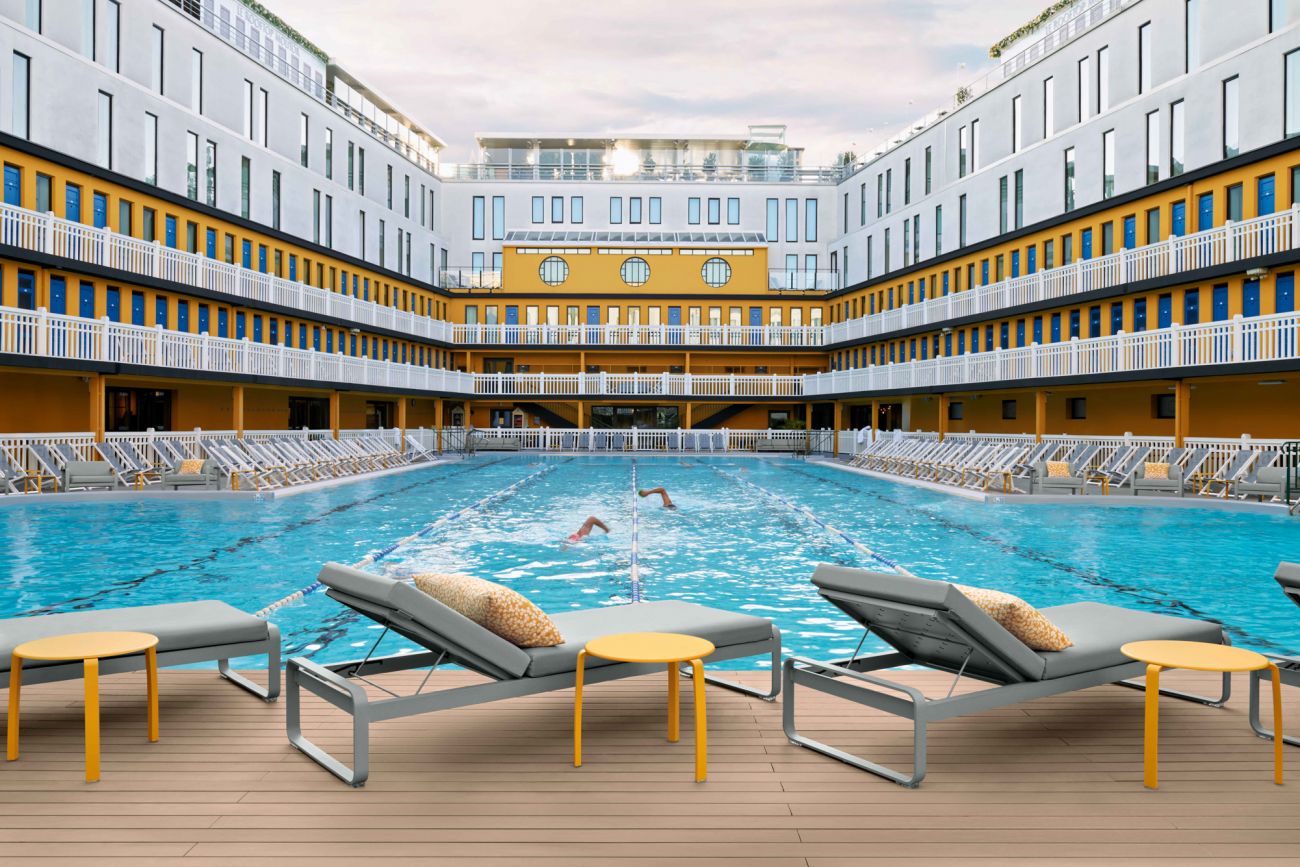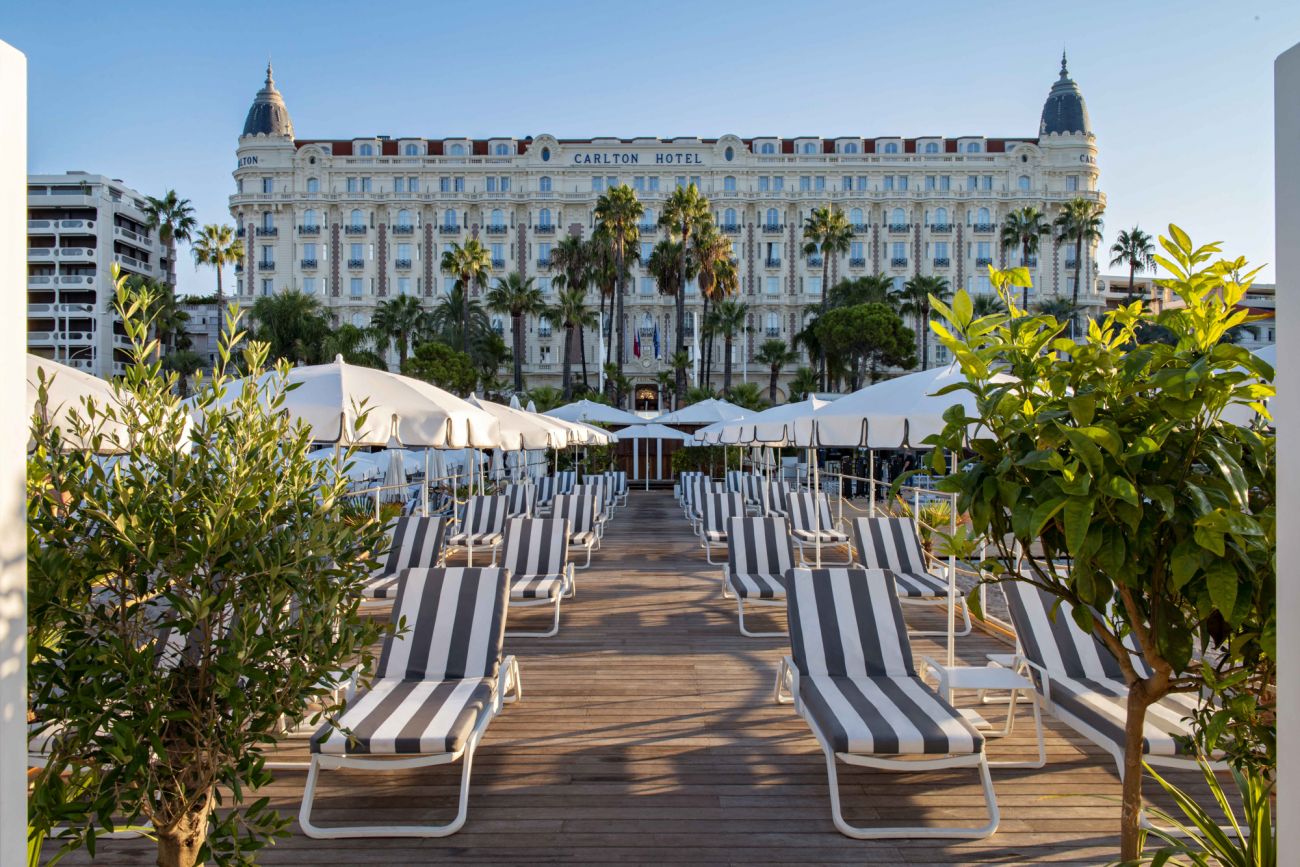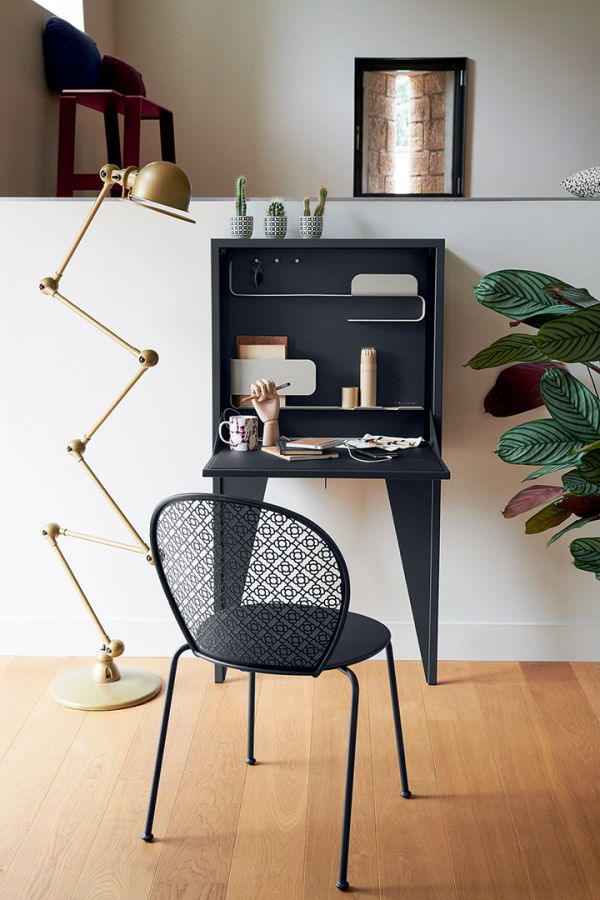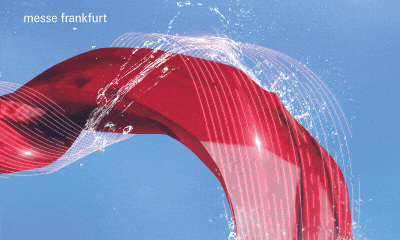 |
INTERVIEW - FLORENCE FERRAND AND MARJORIE ANTOINE, FERMOB: "CREATIVITY FEEDS OFF DISCUSSIONS AND EXCHANGES"
Fermob is the story of a French manufacturer that keeps pace with changing needs, creates trends and combines technology with craftsmanship to create timeless designs. |
Catégorie : Monde - Interviews et portraits
- Produits et Fournisseurs
- Fournisseurs - Interviews
Interview de Sonia Taourghi le vendredi 16 février 2024
 Swimmingpool at the Hotel Molitor, Paris, designed by Fermob
Crédit photo © Nicolas Matheus / Fermob
Fermob was founded at the end of the 19th century with its very first collections of iron furniture. It was in 1889 that the Bistro folding chair went on sale, proving an instant hit with pub owners, and has remained an iconic Fermob product to this day. Behind this design icon lies the manufacturer's commercial ingenuity: simple and quick to put away, the chair saves pub owners from having to pay the licence fee for a fixed terrace! Fermob respects the know-how that it itself popularised, and today is the last company to be able to hot-forge its products by hand. Each piece of furniture is made unique by hand.
As part of this quest for excellence, the Fermob group took over Roland Vlaemynck in 2013, revitalising the teak and weaving brand. The company thereby also added a new string to its bow: the professional sale and hire of furniture combining multi-material expertise with a mastery of textile manufacture.
As Florence Ferrand, Brands and Customer Relationship Director, and Marjorie Antoine, Director of Contract Sales Europe, point out, "Fermob is a contemporary brand with a strong commitment to human values, a love of work well done, innovation and a deep respect for the environment". They talk to the Journal des Palaces about the milestones in this extraordinary journey, and the development strategies, particularly in the hotel sector, that are maintaining Fermob's reputation and commercial success.Journal des Palaces : What were the key moments in the history of the Fermob brand and its ongoing success?Fermob : Fermob developed the Bistro range from the original Simplex model described in the 1889 patent - of which the brand is the holder - a collection full of ingenuity, simplicity and fun that has lost none of its charm or authenticity!
The 1900 collection is steeped in history, with spiral lines inspired by the wrought-iron balconies of 18th-century Parisian buildings - decorations echoed in the outdoor furniture stemming from a very French tradition of romantic gardens.
The company has also undergone a number of strategic and managerial changes. Fermob experienced a real boom in 1989, when Bernard Reybier, the company's current chairman, bought the small historic workshop in Thoissey (near Lyon). He based the company's development on three pillars: making the French brand known internationally, combining the historic expertise of Fermob's craftsmen with great names in design and standing out through innovation in a market using colour as the key lever.
In 2004, designer Frédéric Sofia collaborated with the brand to reinterpret the legendary Luxembourg Garden chairs and armchairs created in 1923 by the workshops of the City of Paris, and which Fermob still manufactures today. The Luxembourg collection, originally created for the gardens of the same name, has acquired legendary status. Its style is emblematic of French design.
When Roland Vlaemynck joined Fermob in 2013, the Vlaemynck brand began its revival. Vlaemynck specialises in the manufacture of outdoor fabrics, is France's leading teak manufacturer and an expert in parasols. Historically, it has been a manufacturer of parasols and cushions for professionals for over 50 years, and since the end of the 1970s has been decking the private beaches of the biggest hotels on the French Riviera as well as the terraces of cafés, hotels and restaurants in France and around the world. With the integration of the Ghigliano company in the 90s, the Vlaemynck brand became an undisputed powerhouse with more than 98% of the beaches on the Côte d'Azur supplied with parasols and beach mattresses for hire and maintenance.
In 2015, Fermob led the nomadic trend with its first portable lamps. Today, the ranges also focus on multiple uses to create the atmosphere that will set the tone for terraces and living rooms alike...And this year, Fermob is opening up to new materials - wood and leather - and exploring the world of interiors even further through its iconic products. Today, Fermob has gone so far as to shake things up and break down the boundaries between the outside and the inside, and to take advantage of the intelligence of its uses to free itself from labels.What are the specific manufacturing processes that make Fermob furniture so special?Our furniture is made of metal, an eco-responsible choice: steel and aluminium are 98% recyclable. What's more, we're going to "push" our sourcing to increase the recycled metal content in our products.
Our approach has been virtuous and responsible for over 30 years, and we have developed clear guidelines for the design and manufacture of our products.
Fundamental design work to optimise the use of materials (eco-design): this enables us to use the right amount of materials and therefore limit our production waste, for example.
The use of solvent-free powder paint, deposited by electrostatic effect, 100% recycled and recyclable, without heavy metals or phosphates, sprayed by a high-performance, zero-emission installation, which also allows us to be economical in terms of water consumption since it circulates in a closed loop in this installation (-43% water consumption between 2015 and 2021).
And last but not least, UV-resistant formulations guarantee long-lasting products, and 'fair' packaging to help the environment.What services do you offer specifically for hospitality professionals?Our job is to create unique layouts for our customers, by combining products, different furniture formats, colours, materials, etc., while taking into account the specific nature of the venue, the day-to-day needs of the technical teams and the desired emotion for the end customer. What's more, Fermob and Vlaemynck's products are designed to be handled and moved with ease.
We work with hundreds of hotels around the world, in France, Europe, the United States, Australia and Asia.... From lifestyle hotels to palaces, we're lucky enough to have worked with some of them for decades - they're true partners. With each of them, we work hard to choose the layout, materials and colour combinations that allow each location to express its personality and style.
Hotels are special customers because they have several living areas to furnish in one space: bedrooms, seminar rooms, rooftops, terraces, spas, swimming pool areas, etc. Each area must be designed and thought out as a unique space to match an atmosphere and the search for an emotion! That's why we love working with this type of establishment.
We have worked with the Carlton and the Martinez in Cannes, the Molitor in Paris, the Abbaye de Talloires in Talloires, the Castelbrac Hotel in Dinard, and in Germany with the Steigenberger Grandhotel & Spa Petersberg in Königswinter and the New Wave Hotel in Norderney.
Generally speaking, our Special Projects department is aimed specifically at professionals who are looking for something special in their furnishings: specifiers, designers, contract retailers, end customers for projects, head offices, etc. We can adapt our products, offer special colours based on RAL, and integrate other textiles from the finest brands. We can even design made-to-measure products if they so wish, as long as the request falls within our manufacturing know-how.
We take care of everything from project design to technical installation, including 3D drawings, delivery and after-sales service. We support them from A to Z, throughout the life of our products within the establishment.Is there a hotel project of which you are particularly proud?Among the many hotel projects we've been lucky enough to be involved with, we're often happy to mention the Molitor Hotel, with which we've been collaborating for over 12 years.
Our relationship with the Molitor Hotel is a prime example of the kind of partnership we can have with a luxury hotel. For the past 12 years, we have been working with the hotel's teams to completely change the layout of the pool and rooftop every three years, with the aim of renewing the experience for their customers.
In their specifications, the Molitor teams wanted to regularly change the style of their spaces, but also wanted the furniture to be reusable.
To meet these requirements, we decided together to take out leasing contracts and made a commitment to the hotel's management that we would take back the furniture at the end of the three-year lease to give it a second life, either by reselling it to other properties or donating it to charities.
In 12 years, we have built four magnificent and unique facilities that have enabled this hotel to shine. It's a virtuous circle for both the hotel and the manufacturer, and we're very proud of this partnership.What are the specific expectations of luxury hotels?The key words we can use to express the expectations of our luxury hotel customers are: quality, attention to detail, design, colour combinations, uniqueness, a complete offer, advice and service. Beyond our products, what our customers expect from us is to respect the codes of their brand, to help them sublimate their spaces to meet the demanding requirements of their own customers.
For many hotels, the fact that we are manufacturers is a major advantage that helps them to choose our products. Thanks to our production facilities, we can adapt our offer and propose product adaptations or the integration of specific fabrics, for example, to meet their high-end specifications.What trends have you identified in luxury hotels?There are several clear trends. The rooftop is a must for urban luxury, a new 'weapon of mass attraction' for luxury properties.
There is also a trend towards eco-responsibility: hotels that are closer to nature, respectful of the environment and looking for sustainable furnishings. Luxury goods brands are, by their very nature, vehicles for 'timeless' products. They design and manufacture quality products that implicitly embody the notion of sustainability, using noble materials and exceptional craftsmanship.
In terms of design/style, nature is invading the interiors, and there is a desire to reconstitute the private place in public places, i.e. each furnished space has its own personality to create a unique place (personalisation of each room) / hotels are capitalising in style/design on authenticity and their local roots.
A quest for exclusivity, with furniture that reflects the image of the hotel, featuring an increasingly polished, Instagrammable design, while offering extreme comfort combined with aesthetic appeal (wide seats, soft cushions, detailed finishes, etc.).
And finally, the advent of "Bleisure" (Business/leisure), which opens the door to nomadic workspaces: hotels are creating spaces for their nomadic workers. These are spaces that we cover, notably with the Garden Office collection.Fermob is known to collaborate with artists. What motivates this strategy and what are some of the flagship collections?Because creativity is nourished by exchange and discussion, Fermob regularly collaborates, on a one-off or recurring basis, with designers from all backgrounds, both renowned and up-and-coming, to create collections that are as diverse as they are unique. The result of these encounters is bold, ambitious furniture that always combines aesthetics and functionality, purity and style, comfort and ergonomics.
To name but a few, we have collaborated with Frédéric Sofia (Luxembourg, Lorette, Sixties collections, etc.), Jean-Charles de Castelbajac (Ange collection), Patrick Jouin (Facto, Kate collections), Matali Crasset (Stripe collection), Juliette Liberman (Charivari collection), Tristan Lohner (lighting collections: Balad, Mooon!, Aplô / Studie, Bebop, Piapolo furniture collections, etc.) and others.
Some collaborations are the result of emotionally-charged moments, and have given rise to unique objects, notably with Pascal Mourge, who created Face à Face. In 1989, when Bernard Reybier looked at Fermob as a small workshop, one product convinced him to embark on this adventure: the Face à Face, a writing desk inspired by 17th century writing implements. For him, this piece of furniture is the symbol of the eternal nature of metal: a material that has been worked with since time immemorial, but also capable of being transported into the modern world of today and tomorrow. For Bernard Reybier, the return of the Face à Face is a selfish and nostalgic pleasure, but also a tribute to its creator Pascal Mourgue, who did so much for Fermob during the collaboration and friendship between the two men. This re-edition is accompanied by a moderation of the interior upholstery, but no change to the exterior.
The Face à Face is certainly not a typical outdoor product. It is, however, a product with definite potential in the hotel industry, since it corresponds to very contemporary uses: elegance and space-saving, while at the same time being meaningful. It's functional, meaning it can be used for a specific purpose, but is also aesthetically impeccable when not in use.
Kintbury, designed by Terence Conran, is ideal for traditional catering areas looking to bring a modern touch to terraces. With its traditional style, the Kintbury collection is inspired by the English gardens and French ironwork admired by the designer.
Plage Villebrequin is another special collaboration. After buying the 'Ondine' beach concession in Cannes, the Vilebrequin company wanted to redesign the beach in its own image, so it contacted Vlaemynck for its hire and made-to-measure services. To do so, the company chose the 'director's' seats from the Deauville collection, where the covers were screen-printed with the Villebrequin logo. The fabric of the Vlaemynck sunloungers was worked in collaboration with a textile weaver from the Vosges, Jacquard Français, to represent the Villebrequin brand symbol, the round of turtles.And to complete the beach, Vlaemynck has also made parasols, in Ecru fabric in accordance with the city's criteria.What have these collaborations brought you in terms of technical development and creativity?Our creative teams complement each other. Because creativity feeds off discussions and exchanges, the Fermob family of designers is diverse, from the Fermob in-house design studio to designers from all over the world.
The in-house studio communicates with outside designers, who bring a fresh perspective to the company.It's a real opportunity to spontaneously attract creations from designers all over the world.
They work together regularly to bring projects to life.They work closely with the prototype, development and industrialisation teams, etc. It is important that the designers we work with are familiar with our manufacturing processes and methods.The designer's projects force the company to move forward and achieve milestones. Their challenges lead to new techniques. Their attention to detail is infectious!
 Beach at the Carlton Hotel, in Cannes, designed by Fermob
Crédit photo © Nicolas Matheus / Fermob
 Office wall desk, Face à Face, Fermob, designed by Pascal Mourgue
Crédit photo © Sébastien Erome / Fermob
|
|







